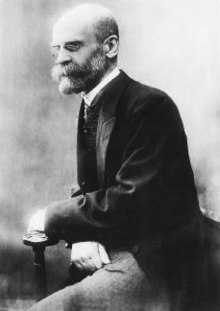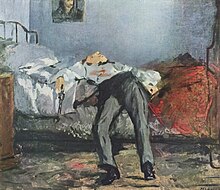Interesting social sciences/Deviant behavior
Emil Durkheim. Suicide.
English subtitles exist in this video. The main cause of suicide is loneliness.On the cover is suicide Sergei Yesenin
Deviant behavior
[edit | edit source]



Deviant behavior is behavior which deviates from norm, this behavior leads to isolation from society, this behavior leads to treatment or punishment of the violator with the purpose to convince or force of people to respect the public norms. Thus, the strengthened measures of social control (supervision and sanctions) are applied in relation of violators.
Three main types of deviant behavior exist:
- addictive behavior,
- criminal behavior,
- suicidal behavior
The addictive behavior consists in escape from reality with help of intake of various psychotropic means – alcohol, drugs, toxins, tobacco smoking. In my opinion, the addictive behavior consists in escape from real conflicts into unreal world. This process is followed by feeling of pleasure and comfort. The use of these surrogates damages health of man always. Man with deviant behavior wants to leave from vital problems, but as a result this man creates new problems - problems with own health. Unsuccessful way of fight against alcoholism was an introduction of "Prohibition" - the prohibition on alcohol sale. "Prohibition" was introduced in the USA in 1920-1932, in Russia and the USSR in 1914-1925, in the USSR in 1985-1989. Introduction of "Prohibition" has led to moonshining blossoming, to deficiency of sugar and yeast, to alcohol smuggling from abroad, to emergence of underground trade by alcohol, to blossoming of criminal world, to wide circulation of toxicomania and drug addiction, to growth of poisonings with help of various alcohol-containing surrogates.
In my opinion, the criminal behavior is steady aspiration to win against opponents in the conflict with the help of illegal means of fight, to win at any cost though opponents use only lawful means in the conflict. Illegal means of fight is illegal advantage in the conflict therefore it is necessary to delete criminals from a game.
Causes of suicides in theory of Émile Durkheim
[edit | edit source]



Name of his main book is "Suicide".
Emile Durkheim sneered concerning abstract reasonings about suicide and Emile Durkheim has undertaken an empirical sociological research of the reasons of suicides. It is well - known that there are psychological and social reasons of suicides. Emile Durkheim tried to prove that suicides are predetermined only by the social reasons, but suicides aren't predetermined by psychological reasons. [1]
According to Emile Durkheim, public consciousness soars over people in society and public consciousness dictates to people to make certain acts. For example, this public consciousness names of person as being, useless for society, because this person is alone, because this person has no family and children, because this person doesn't participate in religious life of community, because this person doesn't play any functions in society, therefore this public consciousness dictates to this person to make the act of suicide and thus public consciousness revenges to this person for refusal from people. Thus, from the point of view of Durkheim, the main reason of suicide is a loneliness. Several psychological reasons of suicides were named before Emile Durkheim. Emile Durkheim has tried to prove by means of results of sociological researches that psychological reasons don't exist for suicide.
- Other authors named such example that person, sick neurasthenia is predisposed to suicide, at which the inclination to suicide became idée fixe (obsessive – compulsive disorder), other authors did generalization that all suicides are mad people because it is possible to kill itself only in a condition of madness.[2] To disprove their point of view, Emile Durkheim has provided data that the number of mad people is especially big among Jews, and the frequency of suicides is very insignificant among Jews. Other fact consists that the number of women (55%) exceeds number of men (45%) a little in madhouses. Whereas the share of women makes only 20% among suicides, a share of men – 80% among suicides. One more fact consists that the inclination to suicide increases from children's age to an extreme old age. Whereas, the maximum danger of a mental disease is observed at the age of 30 years, and danger of a mental disease decreases to a minimum in old age. The number of suicides doesn't depend in this society from number of the alcoholics who exist in this society. Emile Durkheim's merit consisted that he used data of sociological researches in the proof, but not abstract reasonings.
- Other authors claimed that the inclination to suicide is inherited [3], also other authors gave examples of families where suicide cases repeated from generation to generation, for example the French ambassador in the USA Lucien-Anatole Prévost-Paradol has committed suicide in 1870, and his son has committed suicide too after thirty years. Other authors calculated percent of suicides for each race. According to other authors, the highest inclination to suicide is observed at Germans, inclination to suicide is lower at the people of Romance group, inclination to suicide is else lower at Slavs. According to other authors , even the same tool served for commission of the act of suicide in one family for many years. To disprove this point of view, Emile Durkheim has provided data that though men and women receive identical heredity, but men and women have different inclination to suicide. Emile Durkheim has provided data that if suicide is a born disease, then why does this born disease not appear in the childhood aged up before 5 years?
- Other authors considered that suicide happens because of imitation [4], for example fifteen disabled people have hung themselves one by one on the same hook in a dark corridor in 1772. As soon as the hook was removed, epidemic of suicides has stopped. To disprove this point of view, Emile Durkheim has shown that waves of suicides aren't observed on the map, this waves of suicides have to extend from one center. Сenters with the high level of suicides exist at this map actually, this centers coincide with big cities.
Emile Durkheim has allocated three types of suicides:
- egoistic suicide,
- altruistic suicide,
- anomic suicide.
The egoism is the aspiration to love only itself, but not other people.
The anomy is a state of partial destruction of moral control, this destruction of moral control exists in modern big cities or this destruction of moral control occurs in the country during revolution or a revolt.
Altruism (from Latin alteri — meaning "other people") — the moral principle ordering the disinterested actions directed to the benefit and satisfaction of interests of other person (other people). As a rule, this concept is used for designation of ability to sacrifice of own benefit for the sake of general benefit.
The person has too great desire at egoistic type of suicide [5] The person has too great desire of money, love, pleasures, fast promotion on service which can't be satisfied at once. This contradiction between opportunities and needs also causes suicide because such person is deprived of influence of family's and group's moral which teaches abstention and helps to reach composure. The maximum level of suicides is observed among Protestants in comparison with representatives of others of religion since Protestants confess the egoistic morals of personal enrichment. Jews lived in conditions of pressure and prosecution from outside surrounding them nationalities always therefore Jews were forced to live in peace and friendship and Jews were forced to help each other therefore very low level of suicides is observed among Jews. Presence of family and a large number of children serves as good prophylactic remedy against suicide threat. The widower has high inclination to suicide.
Examples of altruistic suicide [6]:
- According to custom of Sati, the widow in India is obliged to go voluntarily on a fire where the body of her late husband burns and this widow is obliged to burn down alive, otherwise widow is waited contempt from outside community.
- The captain of the sinking ship in Europe had no right to leave sinking ship, and this captain was obliged to leave on a bottom together with the ship.
It is possible to give also other examples of altruistic suicide:
- The Japanese pilot kamikaze was obliged to dive on the plane with load of bombs to blow up an American aircraft carrier. The Japanese Samurai was obliged to make a Seppuku - to unstitch to itself a stomach - in case of violation of the code of honor "Bushido".
- The Islamic suicide bomber – the shahid - is obliged to detonate a bomb in the center of Jerusalem or Moscow that to intimidate and to kill as much as possible of unbelievers.
- The community of Old Believers burned itself alive that not to fall into hands of tsar's soldiers.
- Old people were obliged to go to the tundra and to die from hunger at peoples of the Russian North because this old people became useless for relatives.
In my opinion it is possible to make the conclusion that the community, the state or Muslim church dictate to the person to commit suicide in all these cases, and the altruist man submits to this pressure easily.
The person is lonely as social atom in the conditions of an anomy in the big city [7]. Modern society developed too quickly that has led to disintegration of family, morals, religion. The number of suicides has increased in the developed countries many times over for the last century. Any violation of balance in society leads to increase of level of suicides therefore the maximum peaks of level of suicides fall on the periods of economic decline or economic blossoming. Growth of quantity of number of suicides during an economic crisis can be explained with the help of rise in unemployment and wage-cut, but why does the number of suicides grows during economic blossoming when wage grows at all people? It turns out that suicides from envy exist during economic blossoming when it seems to the potential suicide man that other people grow rich quicker rather than suicide man.
The number of suicides is reduced during war because society rallies on repulse to the enemy. Poverty protects from suicides in developing countries because poverty has the investigation presence of big families. Condition of apathy and painful melancholy preceded to egoistical suicide, energy and passion preceded to altruistic suicide, irritability and despair preceded to anomic suicide.
The example of anomic suicide is a suicide of the actor or poet on whom the fashion has passed, fate of Sergey Yesenin is an example of this suicide. Percentage of suicide is retained constant in this society for a long time. Suicide is forbidden in Christianity from his basis, suicide is a result of devil anger. Emile Durkheim draws a conclusion that modern increase of level of suicides is a pathological phenomenon, a payment for progress of civilization.
According to Emile Durkheim, the main reason of suicide is a loneliness. In my opinion, the main reason of suicides is failures in the conflict, suicide people are losers in the conflicts, this conflicts are inevitable in society since society is constructed on the conflict and control.
Citations and references
[edit | edit source]- ↑ Emile Durkheim. Suicide. A study in sociology. The free press. New York. Introduction. https://archive.org/details/DurkheimEmileSuicideAStudyInSociology2005/page/n39
- ↑ Emile Durkheim. Suicide. A study in sociology. The free press. New York. Book 1. Extra-Social Factors. Chapter 1. Suicid and psychopathic states'. Page 4. https://archive.org/details/DurkheimEmileSuicideAStudyInSociology2005/page/n39
- ↑ Emile Durkheim. Suicide. A study in sociology. The free press. New York. Book 1. Extra-Social Factors. Chapter 2. Suicide and normal psychopathic states' - race, heredity. Page 30. https://archive.org/details/DurkheimEmileSuicideAStudyInSociology2005/page/n39
- ↑ Emile Durkheim. Suicide. A study in sociology. The free press. New York. Book 1. Extra-Social Factors. Chapter 4. Imitation. Page. 74. https://archive.org/details/DurkheimEmileSuicideAStudyInSociology2005/page/n39
- ↑ Emile Durkheim. Suicide. A study in sociology. The free press. New York. Book 2. Social causes and social types. Chapter 2. Egoistic suicide. Page. 105. https://archive.org/details/DurkheimEmileSuicideAStudyInSociology2005/page/n39
- ↑ Emile Durkheim. Suicide. A study in sociology. The free press. New York. Book 2. Social causes and social types. Chapter 4. Altruistic suicide. Page. 175. https://archive.org/details/DurkheimEmileSuicideAStudyInSociology2005/page/n39
- ↑ Emile Durkheim. Suicide. A study in sociology. The free press. New York. Book 2. Social causes and social types. Chapter 5. Anomic suicide. Page. 201. https://archive.org/details/DurkheimEmileSuicideAStudyInSociology2005/page/n39
